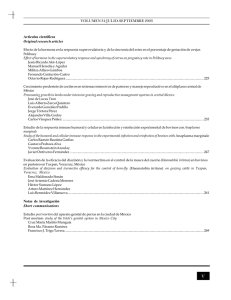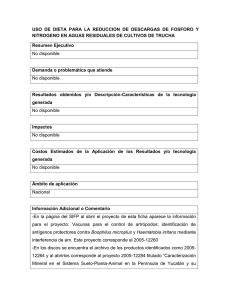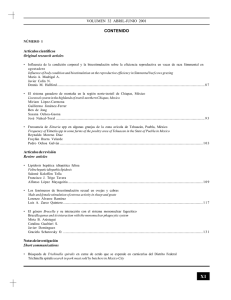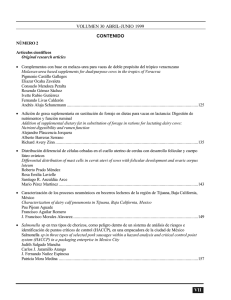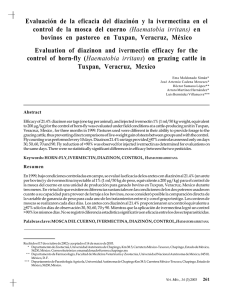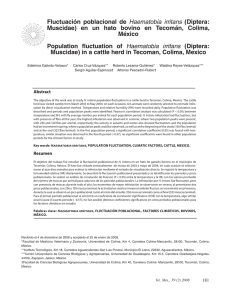rvm34402.pdf
Anuncio
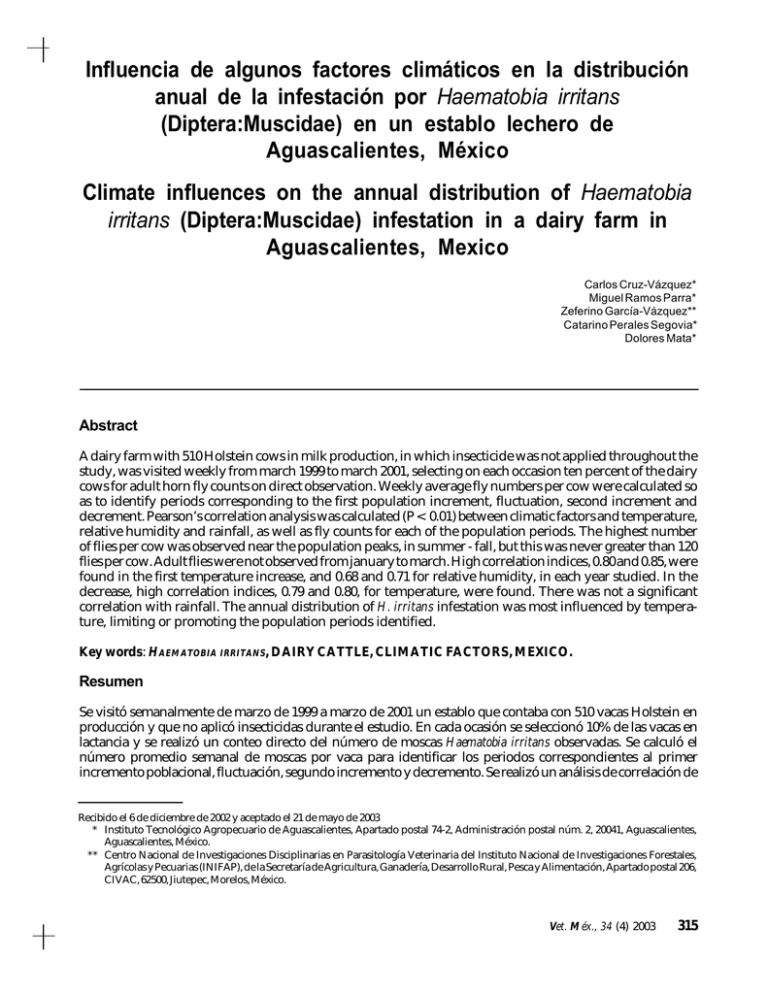
Influencia de algunos factores climáticos en la distribución anual de la infestación por Haematobia irritans (Diptera:Muscidae) en un establo lechero de Aguascalientes, México Climate influences on the annual distribution of Haematobia irritans (Diptera:Muscidae) infestation in a dairy farm in Aguascalientes, Mexico Carlos Cruz-Vázquez* Miguel Ramos Parra* Zeferino García-Vázquez** Catarino Perales Segovia* Dolores Mata* Abstract A dairy farm with 510 Holstein cows in milk production, in which insecticide was not applied throughout the study, was visited weekly from march 1999 to march 2001, selecting on each occasion ten percent of the dairy cows for adult horn fly counts on direct observation. Weekly average fly numbers per cow were calculated so as to identify periods corresponding to the first population increment, fluctuation, second increment and decrement. Pearson’s correlation analysis was calculated (P < 0.01) between climatic factors and temperature, relative humidity and rainfall, as well as fly counts for each of the population periods. The highest number of flies per cow was observed near the population peaks, in summer - fall, but this was never greater than 120 flies per cow. Adult flies were not observed from january to march. High correlation indices, 0.80 and 0.85, were found in the first temperature increase, and 0.68 and 0.71 for relative humidity, in each year studied. In the decrease, high correlation indices, 0.79 and 0.80, for temperature, were found. There was not a significant correlation with rainfall. The annual distribution of H. irritans infestation was most influenced by temperature, limiting or promoting the population periods identified. Key words: HAEMATOBIA IRRITANS, DAIRY CATTLE, CLIMATIC FACTORS, MEXICO. Resumen Se visitó semanalmente de marzo de 1999 a marzo de 2001 un establo que contaba con 510 vacas Holstein en producción y que no aplicó insecticidas durante el estudio. En cada ocasión se seleccionó 10% de las vacas en lactancia y se realizó un conteo directo del número de moscas Haematobia irritans observadas. Se calculó el número promedio semanal de moscas por vaca para identificar los periodos correspondientes al primer incremento poblacional, fluctuación, segundo incremento y decremento. Se realizó un análisis de correlación de Recibido el 6 de diciembre de 2002 y aceptado el 21 de mayo de 2003 * Instituto Tecnológico Agropecuario de Aguascalientes, Apartado postal 74-2, Administración postal núm. 2, 20041, Aguascalientes, Aguascalientes, México. ** Centro Nacional de Investigaciones Disciplinarias en Parasitología Veterinaria del Instituto Nacional de Investigaciones Forestales, Agrícolas y Pecuarias (INIFAP), de la Secretaría de Agricultura, Ganadería, Desarrollo Rural, Pesca y Alimentación, Apartado postal 206, CIVAC, 62500, Jiutepec, Morelos, México. Vet. Méx., 34 (4) 2003 315 Pearson (P < 0.01) entre el promedio semanal de moscas por vaca y temperatura, humedad relativa y precipitación pluvial, en cada uno de los periodos poblacionales. El nivel de infestación fue más alto cerca de los dos picos poblacionales, en verano-otoño, y nunca fue superior a 120 moscas por vaca. Durante el periodo de enero a marzo no se observaron moscas. En el primer incremento poblacional se encontraron altos índices de correlación, 0.80 y 0.85, para temperatura y 0.68 y 0.71 para humedad relativa, en cada año de estudio. En el decremento se observaron altos índices de correlación con la temperatura, 0.79 y 0.80. No se detectó correlación significativa con la precipitación pluvial. La temperatura influyó considerablemente en la distribución anual de la infestación por H. irritans, promoviendo o limitando los periodos poblacionales identificados. Palabras clave: HAEMATOBIA IRRITANS, GANADO LECHERO, FACTORES CLIMÁTICOS, MÉXICO. Introduction Introducción nfestation of cattle by the Haematobia irritans (L.) fly causes losses in meat and milk production, as well as damaging skin quality. Control measures for this ectoparasite are based on the use of insecticides, yet these can lead to the development of resistant fly populations and increase control costs.1-5 This problem is encountered in cattle kept at pasture in the tropics in Mexico, where resistance to insecticides has been noted for some years.6 The rational control of this ectoparasite should be founded upon complete epidemiological knowledge of the infestation in each agro-ecological region and according to each farming practice. Such information would allow for the generation of strategic control programs that would allow sustainable management of the problem.5,7 However, in Mexico there are very few studies to this effect. In a preliminary study the presence of H. irritans was noted in confined dairy cattle in Aguascalientes, which has a semi-arid climate. Later the distribution of the infestation was described for the whole year. It was observed that this problem is linked to the climate. However, the contribution of the main climatic factors on the annual distribution has not been determined.8,9 The main objective of this study was to identify some of the climatic factors that influence the annual infestation distribution of Haematobia irritans in a dairy farm located in Aguascalientes, Mexico. a infestación en el ganado bovino por la mosca Haematobia irritans (L) ocasiona pérdidas en la producción de carne y leche, y daña la calidad de las pieles. Las medidas de control de este ectoparásito se basan en el uso de insecticidas, ello puede conducir al desarrollo de poblaciones de moscas resistentes a éstos y al incremento en los costos de control.1-5 Esta problemática se presenta en el ganado mantenido en pastoreo en el trópico mexicano, en donde se ha notificado la existencia de resistencia a insecticidas desde hace varios años.6 El control racional de esta ectoparasitosis debe fundamentarse en el conocimiento de la epidemiología de la infestación en cada región agroecológica y por sistema de producción ganadero, con ello se puede generar información para diseñar programas de control estratégico que permitan un manejo sustentable del problema;5,7 sin embargo, en México existen escasos estudios al respecto. En un trabajo preliminar se identificó presencia de H. irritans en ganado lechero estabulado en Aguascalientes, de clima semiárido, posteriormente se describió la distribución de la infestación a lo largo de un año. Se observa que este problema se relaciona con el clima; sin embargo, no se ha determinado la contribución de los principales factores climáticos en la distribución anual.8,9 El objetivo principal de este trabajo fue identificar la influencia de algunos factores climáticos en la distribución anual de la infestación por Haematobia irritans en un establo lechero de Aguascalientes, México. Material and methods The study was carried out in the state of Aguascalientes, Mexico, in the central northern area of the country. The region of study is located at 1,885 m above sea level, has an average temperature of 16.9°C, and a semidry-temperate climate that can be extreme. There is an average annual rainfall of 475 mm which is seasonal, being greatest in the summer. The region is made up of the following municipalities: Jesus Maria, 316 Material y métodos El estudio se llevó a cabo en Aguascalientes, México, en la zona centro-norte del país, la región lechera se ubica a 1 885 msnm, con temperatura promedio de 16.9oC y clima semiseco-templado y extremoso; la precipitación anual, que es estacional, es de 475 mm, y se Aguascalientes, San Francisco de los Romo and Pabellon de Arteaga.8 A technically outfitted dairy farm that kept Holstein cattle under a free-stabled regimen was used. This system housing con3sists of open corrals with earthen floors and shaded areas and is of a type found frequently in the semiarid regions of Mexico. Feed consisted of corn silage, fresh-cut forage, hay and concentrate. The stable is located in San Francisco de los Romo and has 510 cows in milk production, all of which were kept throughout the study. The stable was visited weekly during the March 1999 to March 2001 period. During each visit, ten percent of the adult lactating cows were picked, the only criteria being that they were standing, thus facilitating observations.5 A direct visual count of the total number of H. irritans flies observed feeding or resting on each animal was made, employing binoculars when necessary.5,9,10 This count was carried out by the same person on both sides of each cow, between 9:30 and 10:30 in the morning.5 No type of insecticide was applied during the two-year study period. Climatic factors were registered as reported by the San Francisco de los Romo weather station, measuring: average weekly temperature (ºC), relative humidity (% RH) and rainfall (Rf) for each week. The average number of flies per week was calculated for each animal so as to describe the annual infestation distribution curve for the study period and identify periods corresponding to: first population increment, fluctuation, second population increment and decrement, using Guglielmone et al. criteria.10 Pearson’s correlation analysis (P < 0.01) between average weekly flies per animal and each of the climatic factors mentioned, in each of the population periods identified in the study, was carried out. To this end climatic data from one, two, three and four weeks prior to when the corresponding count was taken were compared so as to detect if climatic factors had the same influence in these periods.10 The SAS statistical analysis program was used for all analyses.11 Results The annual infestation distribution curve allowed for the identification of the four population periods mentioned: first population increment (march to july), fluctuation (from july to september in the first year and from july to august in the second), second population increment (from september to october in the first year and from august to december in the second), and decrement (from october to january in the first year and from september to december in the second). During the entire study period the level of presenta en verano. La región está integrada por los municipios de Aguascalientes, Jesús María, San Francisco de los Romo y Pabellón de Arteaga.8 Se eligió un establo lechero tecnificado que mantenía ganado Holstein bajo régimen de estabulación libre. En este sistema los alojamientos consisten en corrales de tierra abiertos con sombreaderos, característicos de las regiones semiáridas de México; la alimentación se basaba en ensilaje de maíz, forraje verde de corte, heno y concentrado. El establo se localiza en San Francisco de los Romo y cuenta con 510 vacas en producción, que conservó durante el estudio. El establo fue visitado cada semana de marzo de 1999 a marzo de 2001, en cada ocasión se eligió 10% de animales adultos en lactancia; se tomó como criterio animales que estuvieran de pie, de manera que facilitaran la observación.5 Se realizó un conteo visual directo del número total de moscas H. irritans que se observaran alimentándose o descansando en cada animal, con la ayuda de binoculares cuando fue necesario.5,9,10 Este conteo se realizó en ambos lados del cuerpo del animal, entre las 9:30 y las 10:30 horas, lo realizó la misma persona.5 No se aplicó ningún insecticida durante los dos años del estudio. Se registraron los factores climáticos obtenidos de la estación climática de San Francisco de los Romo: Promedios semanal de temperatura (oC), de humedad relativa (% HR) y precipitación pluvial (Pp) para cada semana. Se calculó el número promedio semanal de moscas por animal para describir la curva de distribución anual de la infestación en el periodo de estudio e identificar los periodos poblacionales correspondientes al primer incremento poblacional, fluctuación, segundo incremento poblacional y al decremento en los dos años de estudio, de acuerdo con el criterio de Guglielmone et al.10 Se realizó un análisis de correlación de Pearson (P < 0.01) entre el promedio semanal de moscas por animal y cada uno de los factores climáticos mencionados, en cada uno de los periodos poblacionales identificados en el estudio. Para este fin se tomaron los datos climáticos de una, dos, tres y cuatro semanas antes del conteo correspondiente, para detectar si los factores climáticos influían de igual manera en esos periodos.10 Para realizar este análisis se utilizó el programa SAS.11 Resultados La curva de distribución anual de la infestación permitió identificar los cuatro periodos poblacionales mencionados: Primer incremento (de marzo a julio), fluctuación (de julio a septiembre en el primer año y de julio a agosto en el segundo), segundo incremento (de septiembre a octubre el primer año y de agosto a septiembre el segundo) y el decremento (de octubre a enero en el primer año y de septiembre a diciembre en el segundo); se observó Vet. Méx., 34 (4) 2003 317 infestation was low, the highest average number of flies per cow was observed near the two population peaks, in the summer-autumn period, but was never greater than 120 per cow. During the january to march period no flies were observed on the cows (Figure 1). Climatic conditions during the study period indicated that the average temperature was 18.8°C in the first year, and 17.5°C in the second, while relative humidity was, on average, 36.7% and 37.8% in the first and second year, respectively. The highest temperatures were recorded in the spring-summer period, especially from may to june, while the lowest temperatures were found from december to february. Relative humidity was high in summer and autumn, being low in winter and spring. Rainfall was greater in summer and autumn, being low in winter and spring. Total annual rainfall was 253.5 mm and 339 mm for the first and second year, respectively, and was always most abundant in the summer (Table 1). Table 2 shows the significant (P < 0.01) Pearson correlations for each of the years studied per population period determined two weeks prior to counting. The first increment, in the spring-summer period, is explained by the temperature and relative humidity (0.80 and 0.85 coefficients for temperature, and 0.68 and 0.71 coefficients for relative humidity). The fluctuation and second increment periods did not have significant correlation with the climate. However, for the decrement, which took place at the end of autumn and the beginning of que durante el estudio el nivel de la infestación fue bajo, el número más alto de moscas promedio por vaca se observó cerca de los dos picos poblacionales, ubicados en el periodo verano-otoño, nunca este fue superior a 120 moscas por vaca. Durante el periodo de enero a marzo no se observaron moscas parasitando a las vacas (Figura 1). El comportamiento de los factores climáticos en el periodo de estudio indicó que la temperatura promedio en el primer año fue de 18.8oC y en el segundo de 17.5oC, mientras que la humedad relativa fue de 36.7% y 37.8%, en promedio, para el primero y segundo años, respectivamente; las temperaturas más altas se observaron en el periodo de primavera-verano, especialmente de mayo a julio, y las más bajas en el invierno, de diciembre a febrero. La humedad relativa fue más alta en verano y otoño y baja en invierno y primavera. La precipitación pluvial fue de 253.5 mm y 339 mm para el primero y segundo años de estudio, respectivamente; fue más abundante en el verano (Cuadro 1). En el Cuadro 2 se muestran los índices de correlación de Pearson estadísticamente significativos (P < 0.01), para cada uno de los años estudiados por periodo poblacional determinados dos semanas antes del conteo. El incremento 1, en primavera-verano, se explica por la temperatura y la humedad relativa (coeficientes de 0.80 y 0.85 para la temperatura, y de 0.68 y 0.71 para humedad relativa). En los periodos de fluctuación y de segundo incremento no se detectaron coeficientes estadísticamente significativos; para el periodo de decremento (finales de otoño a inicio de invierno) se observó alta correlación con la temperatura (coeficientes de 0.79 y 0.80). No se detectó correla- Figura 1. Distribución anual de la infestación por Haematobia irritans en un establo lechero de Aguascalientes, México. Annual distribution of Haematobia irritans infestation in a dairy stable inAguascalientes,Mexico. 318 winter, there was high correlation with temperature (0.79 and 0.80). Significant correlations with rainfall were not detected in any period. ción estadísticamente significativa con la precipitación pluvial en ningún periodo. Discusión Discussion The annual horn fly infestation distribution is influenced by temperature, both in the first population increment La distribución anual de la infestación por mosca del cuerno se encuentra influida por la temperatura, tanto durante el primer incremento poblacional como en el Cuadro 1 INFORMACIÓN CLIMÁTICA: TEMPERATURA PROMEDIO (TOC), HUMEDAD RELATIVA PROMEDIO (HR %), Y PRECIPITACIÓN PLUVIAL TOTAL (PP MM), DISTRIBUIDA POR ESTACIÓN, DE MARZO DE 1999 A MARZO DE 2001. DATOS TOMADOS DE LA ESTACIÓN CLIMÁTICA DE SAN FRANCISCO DE LOS ROMO, AGUASCALIENTES, MÉXICO. CLIMATE INFORMATION: AVERAGE TEMPERATURE (TOC), AVERAGE RELATIVE HUMIDITY (RH %) AND TOTAL RAINFALL (Rf mm), DISTRIBUTED BY SEASON, FROM MARCH 1999 TO MARCH 2001. DATA TAKEN FROM THE SAN FRANCISCO DE LOS ROMO WEATHER STATION IN AGUASCALIENTES, MEXICO. Season T ( o C) Year 1 RH (%) Rf (mm) T ( o C) Year 2 RH (%) Rf (mm) Spring Summer Fall Winter 21.1 22.3 16.8 15.1 31 45.1 38.5 32.5 9 244.5 0 0 20.4 21.3 14.9 13.7 34 46.1 40.3 31 84.5 179 47.5 28 Cuadro 2 ÍNDICES DE CORRELACIÓN (r) DE ALTA SIGNIFICANCIA ESTADÍSTICA (P < 0.01) ENTRE LA TEMPERATURA PROMEDIO (T), HUMEDAD RELATIVA PROMEDIO (HR) Y PRECIPITACIÓN PLUVIAL (PP) Y EL NÚMERO PROMEDIO DE MOSCAS Haematobia irritansPOR VACA, EN LOS DIFERENTES PERIODOS POBLACIONALES IDENTIFICADOS EN UN ESTABLO DE AGUASCALIENTES, MÉXICO CORRELAITON INDEXES (r) WITH HIGH SIGNIFICANCE (P < 0.01) BETWEEN AVERAGE TEMPERATURE (T), RELATIVE HUMIDITY (RH) AND RAINFALL (Rf), AND THE AVERAGE NUMBER OF Haematobia irritans FLIES PER COW, IN THE DIFFERENT POPULATION PERIODS IDENTIFIED IN A STABLE LOCATED IN AGUASCALIENTES, MEXICO Population periods First year T ( o C) r RH (%) Rf (mm) Increment 1 (march 16 to july 20, 1999) Fluctuation (july 21 to september 07, 1999) Increment 2 (sept 08 to october 05, 1999) Decrement (oct 06 to january 04, 2000) 0.80 ns ns 0.79 0.71 ns ns ns ns ns ns ns Second year Increment 1 (march 14 to july 18, 2000) Fluctuation (july 19 to august 08, 2000) Increment 2 (august 08 to september 05, 2000) Decrement (sept 05 to december 26, 2000) 0.85 ns ns 0.80 0.68 ns ns ns ns ns ns ns ns = non-significant Vet. Méx., 34 (4) 2003 319 and in the decrement period. Relative humidity is also important in determining the first population peak during the summer. The second population peak (second increment) was observed in the summer-autumn period, at which time the weather was warm and humid due to the seasonal rainfall, such that the combination of these elements probably produced favorable conditions for this second population increment. However, a significant correlation was not found, possibly due to the brief time during which the population curve grew and the prevalent climatic homogeneity. Regarding the decrement, it is quite clear that temperature is the only climatic factor that has any influence on population, thus leading to scarce or null adult fly populations in the winter. The previous study carried out on the annual distribution of H. irritans infestation in Aguascalientes suggested the importance of some climatic factors such as temperature and rainfall on said distribution.9 The present study proved the importance of temperature influence on the infestation. Furthermore, regarding the relationship of rainfall and temperature in the seasons in which there are population peaks (summer and autumn), it was observed that it is not so much rainfall that influences the annual distribution, but rather its effect as manifested through relative humidity. In this study the most significant correlation indexes are registered two weeks prior to the fly counts, thus suggesting that the temperature and relative humidity or rainfall conditions that are present two weeks prior to said count, influence the infestation for that period. This value should be considered as unique for this particular study since different elements included in the analysis could cause this correlation to present greater values for a different number of weeks prior to the fly count, such as occurred in an Argentine study, where the most significant correlation indexes were registered four weeks prior to the fly count.10 The influence of these climatic factors on horn fly infestation has been recognized in other farming regions in North America, Argentina and Brazil. Likewise, it has been registered recently in the Mexican tropics.6,10,12-16 These studies coincide in that temperature is the main climatic factor related to seasonal infestation by H. irritans, and is the most important element for facultative diapause to be present, be this partial or complete. Thus in tropical regions with temperate climate and cattle at pasture a lower number of flies has been seen in the winter, yet there has not been complete diapause, while in temperate-cold climates this phenomenon is invariably present during that season.6,10,12-16 In the study region used for the present study, complete diapause has been registered previously in the winter, since no flies have been seen to parasitize the cattle during that time.9 The present study also proved this phenomenon, and even if the methodology employed is not specific for the strict 320 periodo de decremento. En aquél es importante la influencia de la humedad relativa, ya que ambos factores climáticos determinan el primer pico poblacional en el verano. Durante el periodo verano-otoño se presenta el segundo pico poblacional, en ese periodo (segundo incremento) el clima es cálido y húmedo debido a la precipitación pluvial estacional; la combinación de ambos elementos probablemente dan las condiciones propicias para este segundo crecimiento poblacional. Sin embargo, no se detectó ninguna correlación significativa, quizá debido al breve tiempo en que crece la curva poblacional y a la homogeneidad climática prevaleciente. Respecto del decremento, es claro que la temperatura es el único de los factores climáticos que influye en el comportamiento poblacional, que lleva a la escasa o nula presencia de moscas adultas en invierno. En el estudio previo sobre la distribución anual de la infestación por H. irritans en Aguascalientes, se sugería una importante relación entre algunos factores climáticos como la temperatura y la lluvia en la distribución anual descrita.9 En este estudio se comprobó la importante influencia de la temperatura en la infestación; en cuanto a la relación de la lluvia y la temperatura en la época en que se presentan los picos poblacionales, en verano y en otoño, se observó que no es propiamente la precipitación pluvial el factor climático que influye en la distribución anual de la infestación para determinar los periodos de incremento poblacional, sino su efecto manifestado en la humedad relativa. En este trabajo los índices de correlación significativos más altos se registraron dos semanas antes de los conteos de moscas, ello sugiere que las condiciones de temperatura, humedad relativa o precipitación pluvial, presentes dos semanas previas al conteo, influyeron en la infestación en ese periodo; este valor debe ser considerado como particular del caso estudiado, ya que diferentes elementos incluidos en el análisis pueden provocar que esta correlación se presente con mejores valores a diferentes semanas previas al conteo, como sucedió en un estudio en Argentina, donde los índices de correlación significativos más altos aparecieron cuatro semanas antes del conteo.10 La influencia de estos factores climáticos en la infestación por mosca del cuerno ha sido reconocida en otras regiones ganaderas de Norteamérica, Argentina y Brasil; asimismo, ha sido registrada recientemente en el trópico mexicano.6,10,12-16 Estos estudios coinciden en que la temperatura es el principal factor climático relacionado con la estacionalidad de la infestación en H. irritans y es el elemento más importante para que la diapausa facultativa se presente, de manera total o parcial, así en regiones tropicales y de clima templado con ganado en pastoreo se ha observado menor canti- evaluation of said phenomenon, the facts do point to the existence of the diapause, even though there is a chance that it may not be complete. The influence of rainfall on the infestation is a matter of some discussion given that for some authors it is a determinant factor upon the population curve,6 while for others it only exerts its influence through relative humidity, which in turn is determined by the relationship between rainfall and temperature.10 The present study coincides with the second criterion conferring the determinant role for infestation distribution to temperature. The number of flies per cow that was observed in the present study during the two-year study period was never greater than 120 flies per cow. For cattle kept at pasture it is often common to see infestations of 250 or more flies per cow, though treatment is only recommended with infestations greater than 200 flies per cow.5 During a previous study it was observed, much as in the present study, that infestation remained below 100 flies per cow,9 thus suggesting that infestation levels tend to be lower. This could be explained by: a) unfavorable confinement characteristics for the development of immature H. irritans stages in the stables studied, due to the fact that the excreta are stepped on and dispersed by animals and man; b) the contribution of flies through migration from cattle kept at pasture in close proximity to the stable, keeping in mind that it is possible that flies actually come from more distant places; c) the limiting effect on horn fly abundance created by the altitude in the region studied, given that Kaufman et al.17 suggest that in areas located at more than 1800 m above sea level flies populations cannot develop as favorably; surely these reasons play a contributing role in the described situation. It is concluded that the annual H. irritans infestation observed in this study is influenced by some climate factors, especially temperature, that has multiple effects on the infestation, both promoting and limiting the population periods identified. The information available to date suggests that infestation levels tend to be moderate under this housing system, these climatic conditions and this altitude. Acknowledgements The authors wish to thank Sydney Kunz and Maria Teresa Quintero Martinez for their accurate suggestions during the development phase of this study. This study was carried out with financing from the Consejo del Sistema Nacional de Educacion Tecnologica and the Direccion General de Educacion Tecnologica Agropecuaria, of the Secretaria de Educacion Publica, as well as with aid from the International Foundation for Science, in Stockholm, Sweden. dad de moscas en el invierno, pero no una diapausa total, mientras que en regiones de clima templado-frío este fenómeno se presenta invariablemente en esa época del año;6,10,12-16 en la región donde se desarrolló el presente estudio se ha registrado presencia de diapausa total en el invierno, debido a que no se han observado moscas parasitando a los animales durante esa época.9 En el presente trabajo esta situación se ha repetido y se considera que si bien la metodología empleada no es la específica para evaluar estrictamente el fenómeno, los hechos avalan la existencia de la diapausa, aunque cabe la posibilidad de que ésta no sea total. La influencia de la precipitación pluvial en la infestación es motivo de discusión, pues para algunos autores es determinante en la curva poblacional,6 mientras que para otros influye sólo a través de la humedad ambiental, que se determina por la relación entre lluvia y temperatura.10 El presente trabajo coincide con este último criterio que confiere a la temperatura un rol determinante en la distribución de la infestación. El número de moscas por vaca que se observó en este estudio durante dos años consecutivos nunca fue mayor de 120 moscas por cabeza; en ganado mantenido bajo pastoreo es común la infestación con 250 o más moscas por cabeza, aunque solamente se recomienda aplicar tratamiento con infestaciones mayores a 200 moscas.5 En un estudio previo se observó que, como en el presente trabajo, la infestación se mantuvo por debajo de 100 moscas por cabeza,9 esa situación sugiere que los niveles de infestación en el ganado estudiado tienden a ser menores, lo cual puede explicarse por: a) Las características del confinamiento no favorecen el desarrollo de estados inmaduros de H. irritans en los establos estudiados debido a que el estiércol es pisado y dispersado por los animales y el hombre; b) la migración de moscas de ganado mantenido en pastoreo cerca de los establos contribuye a mantener el nivel de infestación, pero es posible que aquélla venga de lugares distantes de los establos; c) la altitud sobre el nivel del mar de la región estudiada limita la abundancia de moscas del cuerno, ya que Kaufman et al. 17 sugieren que en sitios superiores a 1 800 msnm no se desarrollan poblaciones importantes de esta mosca; seguramente estas razones contribuyen a la situación descrita. En conclusión, en la distribución anual de la infestación por H. irritans observada en este estudio influyen algunos factores climáticos, especialmente la temperatura, la cual incide de diferentes maneras en la infestación, promoviendo o limitando los periodos poblacionales identificados. La información disponible hasta ahora sugiere que los niveles de infestación tienden a ser moderados bajo este sistema de alojamiento, condiciones climáticas y de altitud. Vet. Méx., 34 (4) 2003 321 Referencias Agradecimientos 1. Schmidtmann ET. Arthropod pests of dairy cattle, In: Williams RE, Hall RD, Broce AB, Scholl PJ, editors. Livestock entomology. New York: John Wiley & Sons, 1985:223-238. 2. Harvey TI, Launchbaugh JL. Effect of horn flies on behaviour of cattle. J Econ Entomol 1982;75:25-27. 3. Byford RL, Craig ME, Crosby BL. A review of ectoparasites and their effect on cattle production. J Anim Sci 1992;70:597-602. 4. Guglielmone AA, Gimeno E, Idiart J, Fisher WF, Volpogni MM, Quaino O, et al. Skin lesions and cattle hide damage from Haematobia irritans infestations. Med Vet Entomol 1999;13:324-329. 5. Foil L D, Hogsette JA. Biology and control of tabanids, stable flies and horn flies. Rev Sci Tech 1994;13:11251158. 6. Kunz SE, Ortiz-Estrada M, Fragoso-Sánchez H. Status of Haematobia irritans (Diptera:Muscidae) insecticide resistance in northeastern Mexico. J Med Entomol 1995;32:726-729. 7. Almazán GC, Castillo SS, Loredo OJ, García-Vázquez Z. Dinámica poblacional de Haematobia irritans en un hato de bovinos de Soto la Marina, Tamaulipas, México. Vet Méx 2001;32:149-152. 8. Cruz-Vázquez C, Vitela MI, Ramos PM, Quintero MMT, García-Vázquez Z. Presencia de Haematobia irritans (L.) (Diptera:Muscidae) en ganado lechero estabulado de Aguascalientes, México: Informe preliminar. Vet Méx 1999;30:205-208. 9. Cruz-Vázquez C, Bautista HJ, Vitela MI, Ramos PM, Quintero MMT, García-Vázquez Z. Distribución anual de Haematobia irritans (L) (Diptera:Muscidae) en tres establos lecheros de Aguascalientes, México. Vet Méx 2000;31:195-199. 10. Guglielmone AA, Anziai OS, Mangold AJ, Giorgi RE, Volpogni MM, Flores SG. Seasonal variation of Haematobia irritans (Diptera:Muscidae) in recently infested region of central Argentina. Bull Entomol Res 1997;87:55-59. Se agradece a Sydney Kunz y a Ma. Teresa Quintero Martínez sus acertadas sugerencias durante el desarrollo de este trabajo. La presente investigación fue realizada con el financiamiento del Consejo del Sistema Nacional de Educación Tecnológica y de la Dirección General de Educación Tecnológica Agropecuaria, de la Secretaría de Educación Pública, así como del apoyo de la International Foundation for Science, de Estcolmo, Suecia. 322 11. Statistical Analysis System. SAS user’s guide: statistics. Cary (NC):SAS Institute, 1985. 12. Guglielmone AA, Volpogni MM, Quaino OR, Anziani OS, Mangold AJ. Long term study of Haematobia irritans (Diptera: Muscidae) seasonal distribution in central Argentina with focus on winter fly abundance. Parasite 2001;8:369-373. 13. Lysyk TJ, Moon RD. Diapause induction in the horn fly (Diptera: Muscidae). Eviron Entomol 1994;28:387-397. 14. Kunz SE, Cunninham JR. A population prediction equation with notes on the biology of the horn fly in Texas. Southwest Entomol 1977;2: 79-87. 15. Mendes J, Linhares AX. Diapause, pupation, sites and parasitism of the horn fly, Haematobia irritans, in southeastern Brazil. Med Vet Entomol 1999;13:185-190. 16. Barros ATM. Dynamics of Haematobia irritans (Diptera: Muscidae) infestation on Nelore cattle in the Pantanal, Brazil. Mem Inst Oswaldo Cruz 2001;96:445-450. 17. Kaufman P E, Lloyd JE, Kumar R, Campbell JB, Boxler DJ. The differences between horn fly densities on cattle pastured in Wyoming and Nebraska as possibly influenced by elevation. Southwest Entomol 1999;24:115-121.
